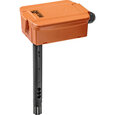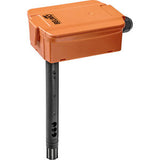Air Quality Sensors - How They Work
Figure 1: Air quality sensor
Air quality sensors are electronic devices that detect and quantify the concentration of pollutants and contaminants present in the air. These sensors play a critical role in safeguarding human health and environmental well-being in both industrial and residential settings. Air quality sensors employ various sensing mechanisms, such as electrochemistry, non-dispersive infrared (NDIR), and light scattering, to measure a multitude of air pollutants. Common targets include:
- Particulate matter (PM): PM1, PM2.5, and PM10 fractions, which are microscopic particles suspended in air and linked to respiratory problems.
- Gasses: Carbon monoxide (CO), carbon dioxide (CO2), nitrogen dioxide (NO2), ozone (O3), sulfur dioxide (SO2), and volatile organic compounds (VOCs), all of which can have detrimental health effects at elevated concentrations.
Table of contents
- Significance
- Installation
- Application example
- Selection criteria
- Air quality sensor calibration
- FAQs
View our online selection of air quality sensors!
Significance
Air quality sensors monitor and provide data on the quality of air in a given environment, which has several important implications:
- Emission control: Air quality sensors are instrumental in industrial/commercial settings for monitoring emissions from manufacturing processes. This real-time data from the air quality sensor allows for adjustments to optimize operations and ensure compliance with environmental regulations.
- Worker safety: Early detection of hazardous gas leaks or spikes in pollutant concentrations safeguards personnel by enabling prompt activation of ventilation systems or emergency protocols.
- Indoor air quality (IAQ): Air quality sensors can be deployed in homes and buildings to identify and address indoor air pollution sources, such as mold, off-gassing building materials, or inadequate ventilation.
- Health management: For individuals with respiratory conditions like asthma, air quality sensors can provide valuable insights for managing exposure to air pollutants that may trigger symptoms.
Installation
The placement of air quality sensors is critical for accurate and effective monitoring.
- In industrial settings, sensors are typically installed at emission sources, such as exhaust stacks, and in areas where employees are likely to be exposed to pollutants.
- Outdoor air quality sensors are often placed at various strategic locations throughout cities and communities to monitor ambient air quality. These locations may include traffic intersections, industrial areas, residential neighborhoods, and near schools or hospitals.
- For residential applications, air quality sensors are usually installed in living spaces, bedrooms, kitchens, and basements. It is important to place sensors away from direct sources of pollution (e.g., stoves, chimneys) to avoid distorted readings and ensure that they reflect the overall indoor air quality.
Application examples
By monitoring pollutant parameters, an HVAC system can adjust its operation to maintain or improve the air quality within a space, for example, by increasing ventilation when high levels of CO2 are detected or adjusting humidity levels. This integration enhances the comfort and health of the building's occupants by ensuring that the air they breathe is clean and well-circulated.
An air purifier equipped with an air quality sensor actively monitors the levels of pollutants and particulates in the environment in real-time. Based on the data collected by the sensor, the purifier adjusts its filtration settings automatically, increasing its intensity when pollutant levels are high and conserving energy when the air is cleaner. This dynamic adjustment ensures that the air purifier operates optimally, removing contaminants such as dust, pollen, smoke, and volatile organic compounds (VOCs) more efficiently. Consequently, this integration significantly improves indoor air quality, making the environment healthier and more comfortable for occupants.
Selection criteria
Consider the following criteria while selecting an air quality sensor:
- Types of pollutants detected: Ensure the sensor can measure the specific pollutants of interest, such as carbon dioxide, temperature, absolute humidity, dew point, and volatile organic compounds (VOCs). The capability to monitor multiple parameters with a single device can be advantageous for comprehensive air quality assessment.
- Compatibility with monitoring systems: The sensor should offer output signals that are compatible with existing or planned monitoring systems. Common output signals include 0-5V, 0-10V, and 4-20mA. The choice depends on the requirements of the control system or data logger to which the sensor will be connected.
- Physical compatibility: The physical dimensions of the sensor, including length and diameter, should be suitable for the intended installation location, whether it be in ducts, tubes, or open air. Ensure the sensor size aligns with the mounting requirements and spatial constraints.
- Integration with building management systems (BMS): For sensors used in environments with BMS, it is important to select sensors that support relevant communication protocols, such as BACNET MSTP or Modbus RTU. This ensures seamless integration and data exchange with the BMS.
- Measurement range and accuracy: The sensor should have a CO2 measuring range and accuracy that meet the requirements of the application. Consider the typical concentration levels expected in the monitored environment to ensure the sensor can provide accurate and reliable measurements.
- Environmental protection and durability: Choose sensors with an appropriate degree of protection (e.g., IP65) to ensure they can withstand the environmental conditions where they will be installed. UV resistance is also important for sensors exposed to sunlight.
- Power supply requirements: Verify that the sensor's rated supply voltage matches the available power supply, whether AC or DC.
- Technology: Choose sensors that use reliable and proven technology, such as NDIR (Non-Dispersive Infrared) for CO2 measurement, to ensure long-term stability and accuracy.
- Installation and mounting: Consider whether the sensor is suitable for the intended mounting type (e.g., duct mounting) and whether it comes with the necessary housing or mounting accessories.
- Additional features: Air quality sensors with features such as wireless connectivity or an integrated display may not be available in all models but could be important for certain applications. Assess the need for these features based on the ease of installation, monitoring requirements, and user interaction.
Air quality sensor calibration
Air quality sensor calibration rectifies discrepancies between a sensor's readings and those of a known, high-accuracy reference monitor. This process adjusts the sensor's output to align with the actual pollutant concentrations in the environment.
Two main approaches are used:
- Co-location: The sensor and reference instrument are placed side-by-side for a period, collecting simultaneous measurements. Statistical models are then derived to correlate the sensor's data with the reference values, enabling correction of the sensor's readings.
- Pre-calibration: Manufacturers may pre-calibrate sensors in controlled environments using standardized gas mixtures. This offers a basic level of accuracy but may not account for variations in real-world deployment conditions.
Advanced air quality sensors with a dual-channel self-calibration mechanism ensure accurate and reliable CO2 monitoring in various settings, even where traditional calibration methods fail. Unlike Automatic Background Calibration (ABC), which relies on regular exposure to fresh air with known CO2 levels to adjust sensor readings, this self-calibration uses two independent channels to automatically correct measurements. This is crucial in environments where the air doesn't regularly return to a baseline CO2 level, making these sensors adaptable and dependable across different buildings and applications without the need for manual calibration.
Read our HVAC instruments article for more information on the various instruments used for control and monitoring an HVAC system.
FAQs
What do air quality sensors measure?
Air quality sensors measure pollutants like CO2, VOCs, PM2.5/PM10, NO2, and O3 in the air.
What is a portable air quality sensor?
A portable air quality sensor is a compact, mobile device that monitors air pollution levels on the go.





